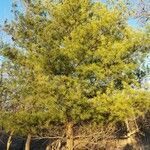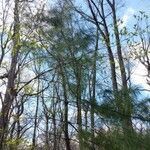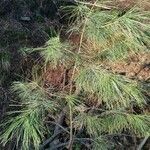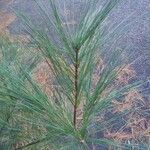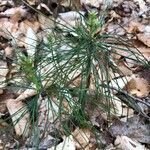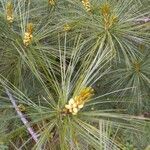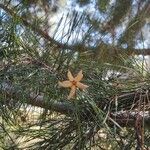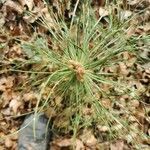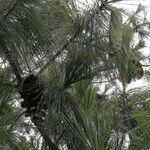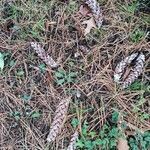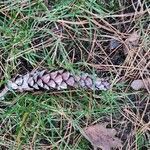Small to large tree, pyramidal at least until after maturity, with crown irregular later. Bark smooth, greyish green until fully developed then rough towards base. Shoots brown or greenish brown, usually somewhat puberulent at first, latter glabrous except for tuft of hairs beneath insertion of lf fascicles, sometimes completely glabrous. Buds narrow-ovoid, greenish, not resinous; scales with free acuminate apices. Foliage in dense masses towards branch ends. Lvs 5 per fascicle, 4-13 cm × 0.5-0.7 mm, soft and tending to droop; resin canals marginal; sheaths deciduous by mid-summer. ♂ strobili < 1 cm long, narrow-cylindric. Conelets stalked, cylindric; scales rounded or obtuse. Cone stalks ± recurved, to 2 cm long. Mature cones solitary, deciduous, falling intact, 7-16 × 3-5 cm when open, cylindric, ± symmetric but often curved, yellowish brown, somewhat tapering towards apex; scales thin, flexible; apophyses rounded; umbo smooth; scar very resinous. Seed wing narrow, to c. 1.5 cm long.
Trees to 65 m tall; trunk to 1.8 m d.b.h.; bark gray-brown, deeply furrowed, with irregularly oblong, long, scaly plates; crown conical, becoming rounded or flattened on top; winter buds light red-brown, ovoid-cylindric, slightly resinous. Needles 5 per bundle, not pendulous, deep green to blue-green, slightly twisted, 6-14 cm × 0.7-1 mm, pliant, stomatal lines present on all surfaces, base with early shed sheath 1-1.5 cm, margin finely serrulate. Seed cones clustered, pedunculate (peduncle 2-3 cm), gray-brown or pale brown with purple or gray tints, cylindric, ellipsoid, or lanceolate-cylindric when open, 7-20 cm, maturing in 2 years, then soon shedding seeds and falling. Apophyses slightly raised, apex resinous; umbo terminal. Seeds red-brown, black mottled, broadly and obliquely obovoid, compressed, 5-6 mm; wing pale brown, 1.8-2.5 cm.
A tree. It grows to 65 m tall. The trunk is 1.8 m across. The bark is dark brown and deeply furrowed. It has irregular oblong, long scaly plates. The crown is cone shaped but becomes rounded or flattened. There are 5 needles per bundle. They do not hang down and are deep green. They are slightly twisted and 6-14 cm long by 0.7-1 mm wide. They are not stiff. The seed cones are clustered and have a stalk. It is 2-3 cm long. The cones are grey brown with purple tints. They are 7-20 cm long. They take 2 years to mature then shed their seeds and fall. The seeds are red-brown with black mottle. They are broadly oval and 5-6 mm across. The wing is pale brown and 1.8-2.5 cm wide.
Tall tree, to 70 m, with long, irregular branches; bark becoming thick, dark, and furrowed; wood pale, soft, not very resinous; lvs very slender, in 5’s, mostly persisting 2 years, pale green and glaucous, 8–13 cm, with 1 fibrovascular bundle; bundle-sheath deciduous; cones commonly borne near the tips of the longer branches, cylindric, often bent, 10–15 cm, the apophysis not thickened, the umbo resinous and terminal, unarmed; seed (wing included) 2–3 cm. Many habitats, esp. in fertile or well drained, sandy soil; Nf. to Minn. and se. Man., s. to Del., n. Ga., Ky., and Io.
